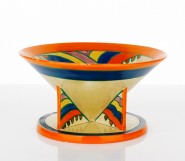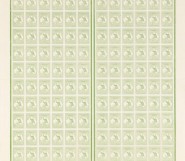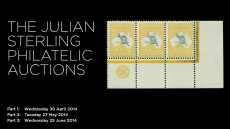Mossgreen
The Julian Sterling Philately Collection - Part 1 - 152 lots
The Julian Sterling Philately Collection - Part 1
-
Auction House:
-
Reference:#MG015
-
Description:JULIAN STERLING (1923–2012)
When Julian Sterling passed away in Melbourne in June 2012, at the age of 88, he spirit and enthusiasm of an extraordinary collector died with him.
Born in 1923 to an immigrant family with roots in Palestine and Russia, Sterling left school early due to serious health issues and spent his entire lifetime educating himself and developing many and varied interests. Julian’s passion for cars led to his establishment of a car dealership in 1953. His immersion in the motor trade afforded him the opportunity to create and add to what would become one of his great collections: that of one of the most exceptional selections of motor cars and motor cycles ever assembled in Australia.
The Sterling Motoring collection was sold by public auction in 2000, and many of the vehicles can now be found in museums and private collections throughout the world.
In the 1960s, Sterling opened the Southern Cross Galleries and Julian’s Antiques and Fine Arts in Melbourne where he pursued his love for studying, acquiring and trading in a wide variety of rare and beautiful items. He was particularly interested in Chinese and South East Asian art and another of his remarkable collections, The Julian Sterling Collection of Chinese and South East Asian Art was sold by the newly-established Australian Auction House, Mossgreen in 2007, with collectors and institutions worldwide competing for the exceptional items in the catalogue.
Despite his advancing years and failing health, Sterling was up for yet another collecting challenge and set his mind to putting together a collection of Australian Commonwealth stamps with the assistance of family members, dealers, collectors, and auctioneers knowledgeable in the field of philately.
He was particularly interested in the Kangaroo and King George V issues that were current during his childhood and during the Depression, but, true to form, was not satisfied with acquiring “one of each”. He searched auction catalogues, private collections and dealers’ stocks looking for exotic, unusual and scarce
items of the highest quality. On this final, relentless quest, he succeeded in unearthing exquisite and rare items that had been held in private collections for decades.
The Julian Sterling Philatelic Collection will be offered for sale by Mossgreen Auctions, recently merged with Charles Leski Auctions, in a series of three auctions between April and June 2014, in Melbourne. This is the first of those catalogues and encompasses the First and Second Watermark Kangaroo issues. Collectors and dealers will be astonished at the sheer quantity of Monogram singles, strips and blocks, Imprint blocks and pairs, varieties, perforation and watermark variants that Sterling managed to assemble in a relatively short time. This truly unique collection of exceptional quality and focus is a fitting final achievement of an extraordinary collector.
Under a unique international marketing plan, Mossgreen Auctions will be providing viewing opportunities for clients in London, and, as a result of a joint-venture agreement with Christoph Gaertner Auctions, viewing will also be possible at the headquarters of that company in Germany.
BLAMIRE YOUNG, POLITICS AND KANGAROOS –
THE EVOLUTION OF A CLASSIC STAMP DESIGN
The first uniform Australian Commonwealth stamp issue made its appearance amid controversy. Probably no other Australian stamp design created more discussion and debate in the community and in political circles as the Kangaroo and Map design. In January 1911, the competition to produce a design for the first Commonwealth stamps was organised. It had originally been intended that four designs would be selected for the full stamp series, but a Federal Cabinet meeting in early December 1910 decided that only one would
be used. Out of the 1,051 designs submitted by 533 participants, the first prize of £100 was awarded to Hermann Altmann of St Kilda, Victoria, for his elaborate, full face portrait of King George V flanked by a kangaroo, emu and six shields bearing the emblems of each state. The second prize of £50 was shared between Donald Mackay of North Finchley, England and Edwin Arnold of Annerley, England. Mackay’s design featured the CommonwealthCoat-of-Arms and Arnold’s depicted a kangaroo.
The competition closed on May 31, 1911 and the results were announced a few weeks later. It was a condition of the competition that prize-winning designs would not necessarily be adopted. Little appears to have happened over the next few months until a new Postmaster-General, Charles Frazer, took office in October 1911. Frazer, who at 31 was one of the youngest Federal ministers in Australia, took an interest in stamps and had questioned the Government in 1907 about its future intentions for a Commonwealth stamp issue, following the report of the Board of Inquiry into the subject. Fraser wanted an assurance that Parliament would be consulted concerning the choice of stamp subjects.
When Frazer assumed office as Postmaster-General he was shown the winning competition entries. However, Altmann’s Royal portrait design did not please him - it was “execrable” he told Parliament later. It was decided that the Victorian Artists’ Association would be asked to nominate an artist to produce an alternative stamp design. The Association chose Blamire Young, a noted watercolourist, who was commissioned to prepare a group of new designs that would be typically Australian in character. “If a picturesque stamp can be provided in which an outline of Australia is featured, I am certainly favourably inclined towards it” Frazer was quoted in the press at the time.
Blamire Young submitted 10 designs to the Post Office in January 1912, all of which are believed to have featured scenes within an outline map of Australia. None of these designs survive today, but it is recorded that one design featured two kangaroos and the map. The exact sequence of events is unclear, but it appears that Frazer resolved to have a design which featured a single kangaroo within a map of Australia. He penned a short instruction on his Ministerial notepaper which read: “1. Get coastline of Aust. 2. Insert Baldy’s Roo. 3. Produce in colours for different denominats.” Baldy was the nom-de-plume of Edwin Arnold, the equal-second prize winner in the 1911 competition and it was Fraser’s wish that Arnold’s standing kangaroo be the principal motif of the very first Commonwealth stamp.
An initial design was produced in horizontal format featuring a kangaroo (Baldy’s Roo) on an outline map of Australia, flanked by draped flags and enclosed in an ornamental frame. This was rejected in favour of a vertical design in the basic style of the issued stamp. The first version in the vertical format had the kangaroo within a map that omitted Tasmania! Also, the denomination was featured within two value circles in the top half of the design. This design was amended to include Tasmania and the top right value circle was dropped, as this could not be accommodated with the increased depth of the map.
Printed examples of this design were produced and released by the Postmaster-General to the Press on April 2 1912, together with the announcement that this was the stamp. In itself, this was an unusual occurrence. Normally, new stamps were issued unheralded, and the public’s first sight of them was after the stamps had gone on sale. Frazer clearly was proud of his Kangaroo stamp and wanted to show it to the public well before the stamps could be issued. On April 3, Fraser distributed examples of these printed essays to his colleagues in the Cabinet.
The newspaper reaction to the released design was generally hostile and mocking in tone. For example,
Argus, Melbourne, April 4 1912: “Our postage stamps go all over the world; they become, in the course of time, a sort of national symbol; and it is therefore very annoying to find that our country is to be represented in the eyes of the world by a grotesque and ridiculous symbol, and that she will be a laughing-stock even to childish stamp collectors of every nation. Mr Frazer had no good reason for departing from Imperial usage in this matter. Australia should do as the rest of the Dominions do; we should all alike have the King’s head printed on our stamps because it is the most obvious and unmistakable symbol of the constitutional bond between the various members of our far-scattered empire. But even if Mr Frazer entertains republican sentiments, and thinks it his duty to express them by means of the national postage he might surely have found some heraldic device more noble and dignified than that absurd kangaroo and that humorous rabbit.”
In the face of this criticism the Postmaster-General did not abandon the Kangaroo & Mapdesign, but he did order two changes as aresult of observations made by critics. The firstwas the insertion of POSTAGE, which in anyevent, was the usual practice so that postage stamps could be distinguished from revenuestamps.The second was the deletion of the small tuft of grass, likened to a pair of rabbit’s ears by critics, and an animal which by then was one of the country’s greatest pests. Frazer promised that the new stamps would be issued by January 1 1913, but there was a delay in the shipment of watermarked paper from England on which the new stamps would be printed. The initial consignment of paper did not reach the Stamp Printing Office in Melbourne until December 30 1912, which meant that only a limited quantity of 1d Kangaroo stamps could be printed and despatched to post offices by the beginning of January 1913. The remaining 14 denominations in the series were issued progressively over the next three months. When the 1d Kangaroo stamps went on sale, a new surge of debate started about the design and, in particular, the omission of the King’s portrait:
The Daily Telegraph, Sydney, January 13 1913: “It is not surprising that there should be an unmistakable expression of public indignation against the new Commonwealth stamp. A feeble-looking kangaroo, perched on the continent of Australia – that is the best idea which those responsible for this production have been able to evolve as to what is required in such circumstances. The kangaroo, be it observed, replaces the head of his Majesty, a result which is likely to arouse in the outside world dubious speculations if not as to the loyalty or at any rate as to the good taste of this part of the King’s dominions.”
In June 1913, a federal election saw the defeat of the Labor government in which Charles Frazer was a Minister. The new Liberal government’s Postmaster-General, Agar Wynne, had plans for the Kangaroo stamps. Two weeks after he became Postmaster-General, Wynne announced that the stamps would be replaced by the winning design in the 1911 competition. In the event, the Altmann design was too complex to be used and a new Royal portrait design was produced and issued as the 1d red engraved stamp in December 1913. Agar Wynne’s decision to scrap the Kangaroo stamps led to a debate in the House of Representatives on August 21 1913, which throws some interesting light on the first Commonwealth stamp. Speaking in the debate, Charles Frazer, explained his reasons for selecting the Kangaroo and Map design:
“A postage stamp is one of the best advertising mediums the country can have. Every letter leaving our shores bears an advertisement of the country on its stamp. Stamps with the King’s head in the design are generally regarded as proper to communications from Great Britain. In designing our stamp we put into it the outline of the coast of Australia. The stamp shows a White Australia, indicating the Commonwealth’s policy in regard to its population. In the centre of the stamp is a
kangaroo, an animal peculiar to Australia and common to every state of the Union. That animal was drawn from the design which took the second prize.”
Frazer’s reference to the white map being symbolic of the White Australia policy is interesting confirmation of something that had been long speculated about. Coupled with the omission of the King’s head, the development of the Kangaroo stamp design was a highly political exercise. However, Charles Frazer did not live to see his beloved Kangaroo stamps effectively ended by the issue of the letterpress 1d George V stamp in July 1914. Frazer died in November 1913 at the age of 33 after contacting pneumonia. His Kangaroo design, however, continued to be used, almost unchanged, until 1946 and has become the most recognised and sought-after of all Australia’s stamp issues.
Adapted from an article by Richard Breckon
entitled “The Kangaroo and Map design”,
published August 2008 -
Sale(s):30 Apr 2014 ~ 2pm
926 - 930 High Street
Armadale, VIC 3143 Australia -
Viewing:27 Mar 2014 ~ 10am - 5pm
The Regus Conference Centre
No 1 Northumberland Avenue
(just around the corner from Trafalgar Square)
London, WC2
United Kingdom
28 Mar 2014 ~ 10am - 5pm
The Regus Conference Centre
No 1 Northumberland Avenue
(Just around the corner from Trafalgar Square)
London, WC2
United Kingdom
02 Apr 2014 ~ 10am - 5pm
Auctionhaus Christoph Gartner & Co
Steinbeisstr. 6 -8
Bietgheim-Bissingen
Germany
03 Apr 2014 ~ 10am - 5pm
Auctionhaus Christoph Gartner & Co
Steinbeisstr. 6 -8
Bietgheim-Bissingen
Germany
26 Apr 2014 ~ 10am - 5pm
926 - 930 High Street
Armadale, VIC 3143
Australia
27 Apr 2014 ~ 10am - 5pm
926 - 930 High Street
Armadale, VIC 3143
Australia
28 Apr 2014 ~ 10am - 5pm
926 - 930 High Street
Armadale, VIC 3143
Australia
29 Apr 2014 ~ 10am - 5pm
926 - 930 High Street
Armadale, VIC 3143
Australia
30 Apr 2014 ~ 10am - 1pm
926 - 930 High Street
Armadale, VIC 3143
Australia
Prices realised in this sale include buyers premium of 24.200%.










































































































